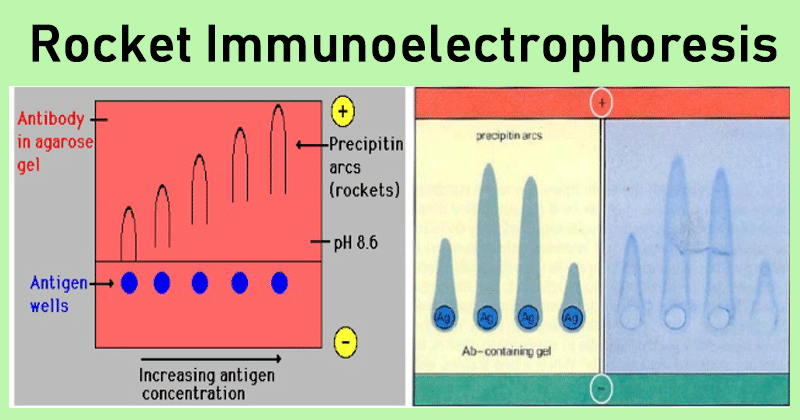- Rocket Immunoelectrophoresis is an adaptation of radial immunodiffusion developed by Laurell. It is also known as electroimmunoassay or electroimmunodiffusion.
- It is called as “rocket electrophoresis” due to the appearance of the precipitin bands in the shape of cone-like structures (rocket appearance) at the end of the reaction.
- In rocket immunoelectrophoresis, antigen migrates in an electric field in a layer of agarose containing an appropriate antibody.
- The migration of the antigen toward the anode gives rise to rocket-shaped patterns of precipitation. The area under the rocket is proportional to antigen concentration.
Interesting Science Videos
Objectives of Rocket Immunoelectrophoresis
- To detect antigen-antibody complexes.
- Determine the concentration of antigen in an unknown sample.
Principle of Rocket Immunoelectrophoresis
Rocket immunoelectrophoresis is a quantitative one-dimensional single electro-immunodiffusion technique. In this method antibody is incorporated in the gel at a pH value at which the antibodies remain essentially immobile. Antigen is placed in wells cut in the gel. Electric current is then passed through the gel, which facilitates the migration of negatively charged antigens into the agar. As the antigen moves out of the well and enters the agarose gel, it combines with the antibody to form immune complex which becomes visible. During the initial phase there is considerable antigen excess over antibody and no visible precipitation occurs. However, as the antigen sample migrates further through the agarose gel, more antibody molecules are encountered that interact with the antigen to form immune complex. This results in formation of a precipitin line that is conical in shape, resembling a rocket.
The greater the amount of antigen loaded in a well, the further the antigen will have to travel through the gel before it can interact with sufficient antibody to form a precipitate. Thus, the height of the rocket, measured from the well to the apex and area are directly proportional to the amount of antigen in the sample.
Materials Required for Rocket Immunoelectrophoresis
Agarose, Antigen, Antiserum, Assay Buffer, Electrophoresis apparatus, Glass slides
Procedure of Rocket Immunoelectrophoresis
- About 15 ml of 1 % agarose gel is prepared.
- The solution is cooled to 55-60oC and 250 µl of antiserum added to 13 ml of agarose solution. It is well mixed for uniform distribution of antibodies.
- Agarose solution containing the antiserum is poured onto to grease-free glass plate placed on a horizontal surface and the gel is allowed to set for 30 minutes.
- The glass plate is on the template and wells punched with the help of a gel puncher.
- 10 µl of the standard antigen and test antigen samples are added to the wells.
- 1X TBE buffer is poured into the electrophoresis tank such that it just covers the gel.
- Electrophoresis is carried out at 80-120 volts and 60-70 mA until the antigen travels 3-4 cms from the well.
- The glass plate is incubated in a moist chamber overnight at 37o C and the results interpreted.
- In case positive for reaction, the tips of the precipitin peaks are marked and the peak height measured from the upper edge of the well to the tip of the peak.
- A graph is plotted of the rocket height (on Y-axis) versus the concentration of antigen (on X-axis) on a semi-log graph sheet. The concentration of the unknown is determined from the graph by finding the concentration against the rocket height.
Result Interpretation of Rocket Immunoelectrophoresis

- A precipitation ‘rocket’ spreading out from the loading well indicate positive reaction or specific antigen-antibody reaction due to the presence of antibody specific to the antigen.
- The absence of the precipitation indicates no reaction or the absence of any corresponding antibody – antigen.
- The height of the rocket, and its area are directly proportional to the amount of antigen in the sample, that is, the height of the precipitin peak depends on the concentration of antigens loaded in the corresponding wells.
Applications of Rocket Immunoelectrophoresis
- Rocket electrophoresis is used mainly for quantitative estimation of antigen in the serum.
- The method has been used for quantization of human serum proteins before automated methods became available.
- Determining the concentration of a specific protein in a protein mixture.
- In estimation of immunoglobulin protease activity.
- Studies dealing with antigenic relationships between organisms.
- In enzyme activity electrophoresis.
Advantages of Rocket Immunoelectrophoresis
- Simple, quick, and reproducible method.
- Several unknown samples can be analyzed on a single plate.
- Concentrations of proteins as little as 1 µg/mL can be measured requiring as little as 20 ng of protein to be loaded in a well.
Limitations of Rocket Immunoelectrophoresis
- These techniques allow quantitative analysis of antigens, but are not applicable to complex mixtures.
Related Techniques
Fused rocket immunoelectrophoresis is a modification of one-dimensional quantitative immunoelectrophorsis used for detailed measurement of proteins in fractions from protein separation experiments.
Two-dimensional immunoelectrophoresis is a variant of rocket electrophoresis. The test is a two-stage procedure. In the first stage, antigens in solution are separated by electrophoresis. In the second stage, electrophoresis is carried out again, but perpendicular to that of first stage to obtain rocket-like precipitation.
References
- Walker JM (1984). Rocket immunoelectrophoresis. Methods Mol Biol. (1): 317-23
- http://himedialabs.com/TD/HTI006.pdf
- Lydyard, P.M., Whelan,A.,& Fanger,M.W. (2005).Immunology (2 ed.).London: BIOS Scientific Publishers.
- Parija S.C. (2012). Textbook of Microbiology & Immunology.(2 ed.). India: Elsevier India.
- Sastry A.S. & Bhat S.K. (2016). Essentials of Medical Microbiology. New Delhi : Jaypee Brothers Medical Publishers.

HI,
DO you have a rough estimate of how much antibody to add to the gel and how much antigen to add. I am trying this out in the lab with second year students.
Dear Sagar, kindly check that in procedure it is 250ul instead of ml and well volume is 10ul instead of ml. Make corrections accordingly.
Thank you so much for the correction. It has been updated.
Thanks,
Sagar